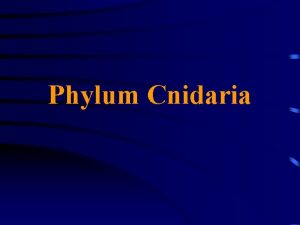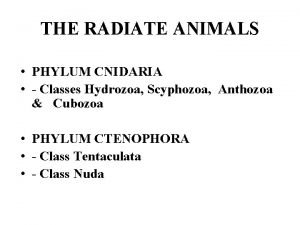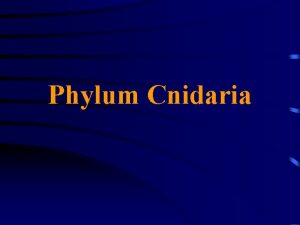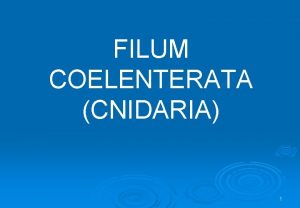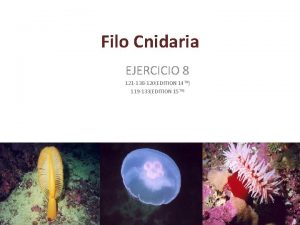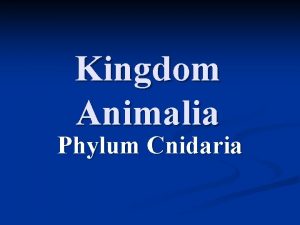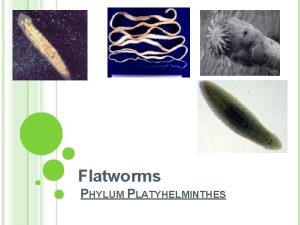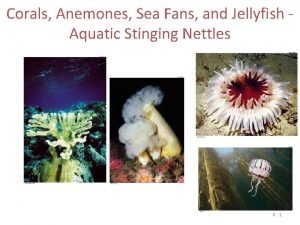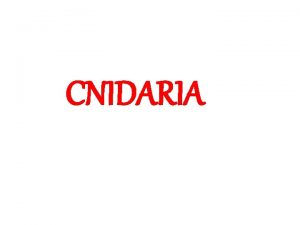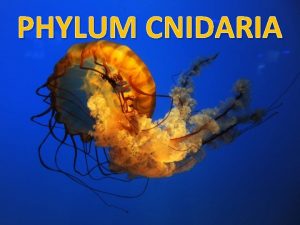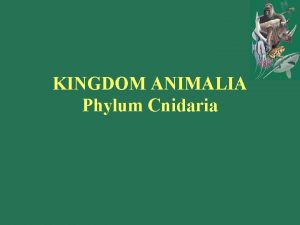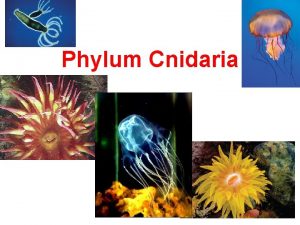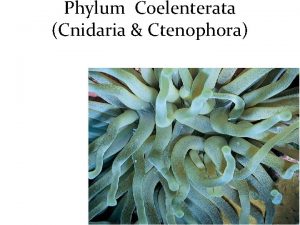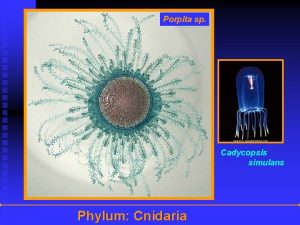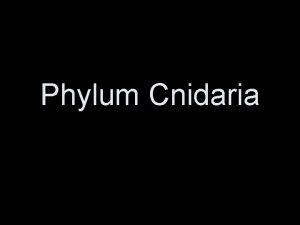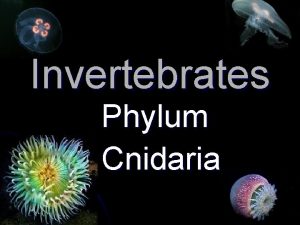Phylum Cnidaria General Characteristics They are radially symmetrical












- Slides: 12

Phylum Cnidaria

General Characteristics • They are radially symmetrical; end with a mouth surrounded by tentacles. • They have 2 tissue layers • Outer layer of cells - the epidermis • Inner gastrodermis, which lines the gut cavity or gastrovascular cavity (gastrodermis secretes digestive juices into the gastrovascular cavity) • In between these tissue layers is a noncellular jelly-like material called mesoglea

Cnidarian Body Plans Polyp form • Tubular body, with the mouth directed upward. • Around the mouth are a whorl of feeding tentacles. • Only have a small amount of mesoglea • Sessile Medusa form • Bell-shaped or umbrella shaped body, with the mouth is directed downward. • Small tentacles, directed downward. • Possess a large amount of mesoglea • Motile, move by weak contractions of body

Nutrition • Cnidarians are carnivores with hydras and corals consuming plankton and some of the sea anenomes consuming small fishes • They use they tentacles to capture prey and direct it toward the mouth so that it can be digested in the gastrovascular cavity via secretions from gland cells (extracellular digestion) • The gastrovascular cavity exists as 1 opening for food intake and the elimination of waste • There is no system of internal transport, gas exchange or excretion; all these processes take place via diffusion

Stinging Organelles • Prey capture is enhanced by use of specialized stinging cells called cnidocytes located in the outer epidermis. • Each cnidocyte has a modified cilium cnidocil, and is armed with a stinging structure called a nematocyst. • The undischarged nematocyst is composed of a long coiled thread • When triggered to release, either by touch or chemical response, the nematocyst is released from the cnidocyte and the coiled thread is ejected • Some nematocysts function to entangle the prey; others harpoon prey and inject a paralyzing toxin

Reproduction • One of the most amazing adaptations is the ability of some cnidarians to regenerate lost parts or even a complete body • Asexual reproduction is common with new individuals being produced by budding • Sea anenomes engage in a form of asexual reproduction called pedal laceration • Cnidariand are dioecious • Fertilization is external, with the zygote becoming a elongated, ciliated, radially symmetrical larva - planula larva Planula larva

Cnidarian Taxonomy

Class Hydrozoa • Includes the solitary freshwater hydra; most are colonial and marine • Typical life cycle includes both asexual polyps and sexual medusa stages; however, freshwater hydras and some marine hydroids do not have a medusa stage

Class Hydrozoa cont. Other Hydrozoans Portuguese man-of-war: Single gas-filled float with tentacles Tentacles house the polyps and modified medusae of the colony

Class Scyphozoa Jellyfish • The medusae are large and contain massive amounts of mesoglea • The differ from the hydrozoan medusa in that the lack a velum • Possess four gastric pouches lined with nematocysts; these are connected with the mouth an the gastrovascular system

Class Anthozoa • Exclusively marine; there is no medusa stage • • Possess a well developed pharynx •

Class Cubozoa • polyps and medusae stages, but medusae dominate with polyp stage reduced. • polyp stage develops directly into medusa. • includes box jellies and sea wasps.
 Phylum cnidaria general characteristics
Phylum cnidaria general characteristics Insidan region jh
Insidan region jh Cubozoa characteristics
Cubozoa characteristics Cnidarian digestive tract
Cnidarian digestive tract Characteristics of phylum cnidaria
Characteristics of phylum cnidaria Ecological importance of cnidarians
Ecological importance of cnidarians Filum cnidaria adalah
Filum cnidaria adalah Hypostome
Hypostome Sea anemone jellyfish
Sea anemone jellyfish Cnidaria characteristics
Cnidaria characteristics Phylum mollusca characteristics
Phylum mollusca characteristics Phylum
Phylum Fire corals and siphonophores are in class
Fire corals and siphonophores are in class
